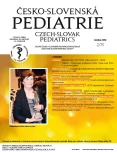Urinary iodine concentrations of pregnant women before delivery
Authors:
D. Neumann 1; K. Krylová 1; J. Kulička 2; A. Jahodová Berková 2; R. Bílek 3; M. Kacerovský 4; M. Bayer 5
Authors‘ workplace:
Dětská klinika Lékařské fakulty v Hradci Králové, Univerzity Karlovy v Praze a Fakultní nemocnice, Hradec Králové
1; Dopravní fakulta Jana Pernera, Oddělení aplikované matematiky, Univerzita Pardubice
2; Endokrinologický ústav, Praha
3; Porodnická a gynekologická klinika Lékařské fakulty v Hradci Králové, Univerzity Karlovy v Praze a Fakultní nemocnice, Hradec Králové
4; Klinika dětí a dorostu, 3. lékařská fakulta Univerzity Karlovy a Fakultní nemocnice Královské Vinohrady, Praha
5
Published in:
Čes-slov Pediat 2018; 73 (2): 79-83.
Category:
Original Papers
Věnováno významnému životnímu jubileu prof. MUDr. Lidky Lisé, DrSc.
Overview
Objective:
To compare urinary iodine concentrations (UIC) in pregnant women before delivery with the recommended UIC values, reported iodine supplementation during pregnancy, iodine status of their newborns and UIC diurnal fluctuations in pregnant women in the study.
Methods:
In the years 2008–2013, UIC in 66 pregnant women before delivery and UIC in 56 newborns on the 3rd day of life were examined. The results were compared with the recommended UIC values and their relation to the reported iodine supplementation was analyzed.
Results:
Thirty-two percent of pregnant women did not use any iodine supplementation during pregnancy. The optimum daily dose of 150 μg was taken by thirty-eight percent of the pregnant women out of those who reported any form of iodine supplementation. The difference in UIC level results of pregnant women before delivery in relation to iodine supplementation was not statistically significant in our sample. In the group of women with iodine supplementation, newborns had median UIC levels above 100 μg/l on the third day of life. There was no evidence of the effect of iodine supplementation on the fluctuations of maternal UIC levels during the day.
Conclusion:
Iodine supplemetation in pregnancy improves the iodine status of newborns.
Key words:
pregnancy, urinary iodine concentration, iodine status, supplementation of iodine
Sources
1. Zimmermann MB, Jooste PL, Pandav CS. Iodine-deficiency disorders. Lancet 2008; 372 (9645): 1251–1262.
2. Bath SC, Steer CD, Golding J, et al. Effect of inadequate iodine status in UK pregnant women on cognitive outcomes in their children: resu lts from the Avon Longitudinal Study of Parents and Children (ALSPAC). Lancet 2013; 382 : 331–333.
3. Meziresortní komise pro řešení jódového deficitu (MKJD). http://www.szu.cz/tema/podpora-zdravi/meziresortni-komise-pro-reseni-jodoveho-deficitu-mkjd.
4. Zamrazil V, Čeřovská J. Jod a štítná žláza. Optimální přívod jodu a poruchy z jeho nedostatku. 1. vyd. Praha: Mladá fronta a. s., 2014 : 1-50. ISBN 978-80-204-3302-2.
5. SACN statement on iodine and health. https://www.gov.uk/.../SACN_Iodine_and_Health_2014.pdf.
6. Alexander EK, Pearce EN, Brent GA, et al. 2017 Guidelines of the American thyroid association for the diagnosis and management of thyroid disease during pregnancy and the postpartum. Thyroid 2017; 27 (3): 315–394.
7. WHO, UNICEF. Reaching optimal iodine nutrition in pregnant and lactating women and young children: a joint statement by WHO and UNICEF. Geneva, World Health Organization; 2007. http://www.who.int/nutrition/publications/micronutrients/WHOStatement__IDD_pregnancy.pdf.
8. Ryšavá L, Kříž J. Prevence jódového deficitu v ČR – historie a současný stav. Prevention of iodine deficit in CZ – history and current situation. In: Ryšavá L, Žoltá M (eds). Zásobení jódem jako prevence tyreopatií a zdroje dietární expozice. Sborník X. konference u příležitosti Dne jódu. České Budějovice, 2013. www.szu.cz/podpora.
9. Jiskra J, Fait T, Bilek R, et al. Mild iodine deficiency in women after spontaneous abortions living in an iodine-sufficient area of the Czech Republic: prevalence and impact on reproductive health. Clin Endocrinol 2014; 80 : 452–458.
10. Andersen SL, Sorensen LK, Krejbjerg A, et al. Challenges in the evaluation of urinary iodine status in pregnancy: The importance of iodine supplement intake and time of sampling. Eur Thyroid J 2014; 3 : 179–188.
11. Smyth PPA, Smith DF, Sheehan S, et al. Short-term changes in maternal and neonatal urinary iodine excretion. Thyroid 2007; 17 (3): 219–222.
12. König F, Andersson M, Hotz K, et al. Ten repeat collections for urinary iodine from spot samples or 24-hour samples are needed to reliably estimate individual iodine status in women. J Nutr 2011; 141 : 2049–2054.
13. Krylová K, Bílek R, Kulička J, et al. Urinary iodine concentrations in mothers and their term newborns in country with sufficient iodine supply. J Matern Fetal Neonatal Med 2017; 30 : 2633–2639.
14. Bílek R, Bednář J, Zamrazil V. Spectrophotometric determination of urinary iodine by the Sandell-Kolthoff reaction subsequent to dry alkaline ashing. Results from the Czech Republic in the period 1994–2002. Clin Chem Lab Med 2005; 43 : 573–580.
15. Institute of Medicine, Academy of Sciences. Iodine. In: Dietary Reference Intakes for Vitamin A, Vitamin K, Arsenic, Boron, Chromium, Copper, Iodine, Iron, Manganese, Molybdenum, Nickel, Silicon, Vanadium and Zinc. Washington, DC: National Academy Press, 2001 : 258–289.
16. Dorey CM, Zimmermann MB. Reference values for spot urinary iodine concentrations in iodine-sufficient newborns using a new pad collection method. Thyroid 2008; 18 : 347–352.
17. Davison JM, Hytten FE. Glomerular filtration during and after pregnancy. J Obstet Gynaecol Br Commonw 1974; 81 : 588–595.
Labels
Neonatology Paediatrics General practitioner for children and adolescentsArticle was published in
Czech-Slovak Pediatrics

2018 Issue 2
- What Effect Can Be Expected from Limosilactobacillus reuteri in Mucositis and Peri-Implantitis?
- The Importance of Limosilactobacillus reuteri in Administration to Diabetics with Gingivitis
Most read in this issue
- Growth plate disorders causing familiar short stature
- Thyroglobulin and other laboratory diagnosis parameters in treating hypothyroidism in children
- ACTH dependent Cushing´s syndrome – case report
- Phenylketonuria: Inovative therapy with sapropterin
